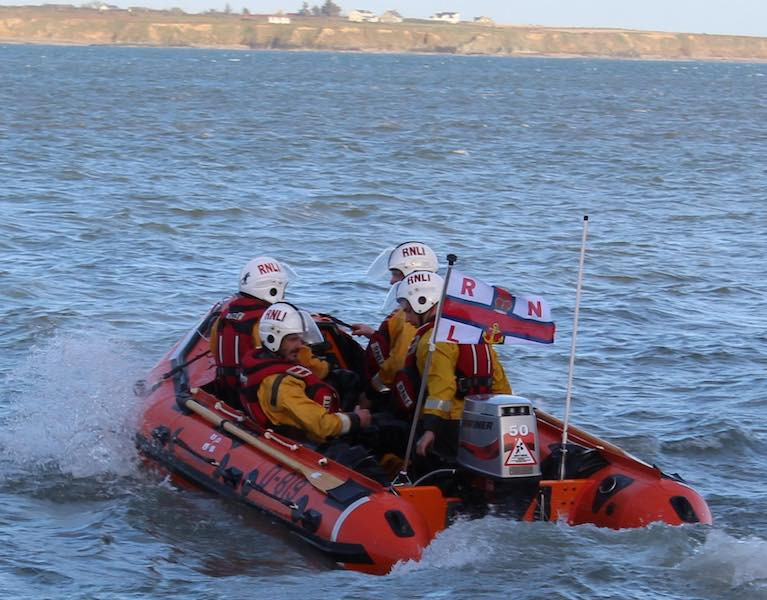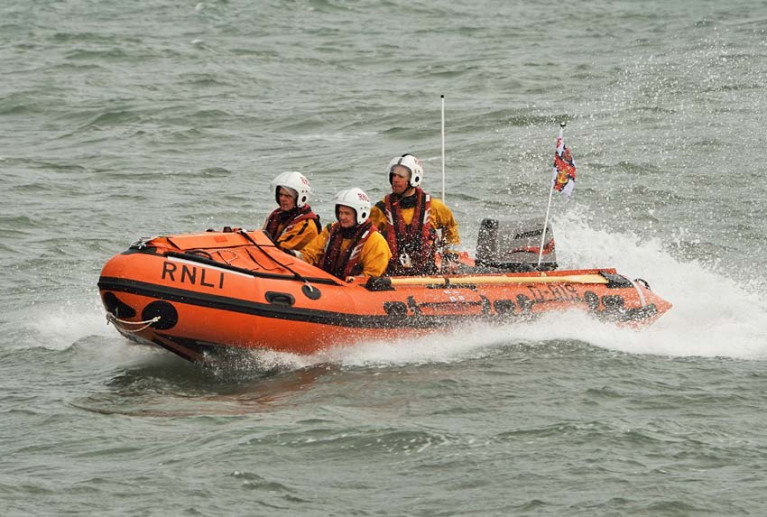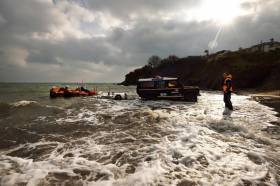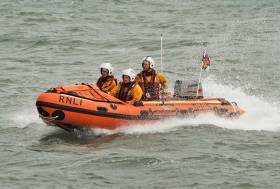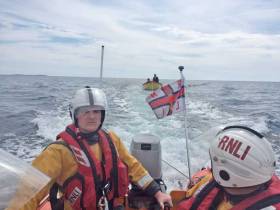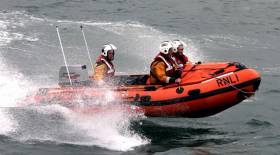Displaying items by tag: Fethard
Fethard RNLI has received a generous €37,000 donation from Integer New Ross this week, after the company’s staff and management chose the lifeboat station as its charity of the year.
Volunteers at Fethard RNLI were delighted to be considered and chosen as Integer’s charity of the year in 2020 and have been overwhelmed by the amount raised.
Receiving the funds raised from Seamus Hamilton of Integer New Ross, Sarah Bates, from Fethard RNLI’s fundraising branch said: ‘We would like to express our sincere gratitude to all the staff at Integer. As a charity, Fethard RNLI totally depends on the goodwill of the public to provide our lifesaving service. This significant donation will continue to help us save lives at sea on the Hook Peninsula and on the River Barrow up to New Ross.
‘These funds will now go towards providing the essential kit our volunteer crew needs to do their lifesaving work and to helping maintain our lifeboat and lifesaving equipment. The funds will also support our crews training. In the last two weeks alone, 12 volunteers undertook training and were awarded with casualty care certificates.’
Walter Foley, Fethard RNLI Lifeboat Operations Manager added: ‘Our station has remained operational throughout the pandemic and our volunteers have continued to be on call adhering to additional safety protocols including wearing extra PPE. We are so grateful for this extraordinary donation from all at Integer during a year when our own traditional fundraising activities had to cease due to Covid-19 restrictions. We would like to thank all the staff for their hard work fundraising and their generosity.’
Fethard RNLI Respond to Call to Help Stranded Walkers Cut off by the Tide off Bannow Island
Volunteer lifeboat crew at Fethard RNLI were requested by the Irish Coast Guard on Sunday evening (28 February) at 5.15 pm to reports of three walkers who had become cut off by the incoming tide with no way of getting to safety. The alarm was raised by a concerned resident of Bannow Island who knew the area well and could see the walkers were in difficulty.
Fethard RNLI’s inshore lifeboat was launched and arrived at Cocklestrand, west of Bannow Island at 5.35 pm. The Kilmore Quay Coast Guard unit was also tasked. Once on scene, the lifeboat crew began the search for the stranded walkers. An extensive search of the north and south shoreline was carried out, but the walkers were nowhere to be seen and had made their own way to safety.
Commenting on the call out Mark Brennan, Fethard RNLI Volunteer Lifeboat Press Officer said: ‘The member of the public did absolutely the right thing, reporting someone in difficulty. It is always better to be safe than sorry and we would much rather launch and find nothing than not launch at all, safety is always our priority. People are keen to exercise outside within government guidelines and we live in a beautiful area with lots of access to the coast. However, we would advise people to keep an eye on their surroundings, in particular, incoming tides and also to watch their footing on the shoreline. Always check the tide times and heights and keep a lookout for incoming tide. Use tide timetables or a tidal prediction app. Make sure you have enough time to return safely. If in doubt, seek local advice.
‘Fethard RNLI remain on call and fully operational during the Covid-19 pandemic. There is no crew training or exercises taking place at the moment, but we are here if people need us.’
Fethard RNLI Aid Two Vessels into Difficulty Over Weekend
Fethard RNLI responded to two incidents in a 24-hour period over the weekend after two vessels, each with two people onboard, got into difficulty in the Waterford estuary.
The first call-out came on Friday evening (9 October), when the volunteer crew were requested to launch their inshore lifeboat by the Irish Coast Guard at 5.15 pm and go to the aid of a Bayliner cruiser with two people on board that had suffered mechanical issues. The vessel had lost power and found itself in difficulty.
Fethard RNLI’s D-Class lifeboat launched from Duncannon Beach and the crew were soon alongside the casualty vessel. There were calm waters at the time and a Force 3 westerly wind. The crew assessed the situation and found that those onboard were safe and well. A towline was then established, and the vessel was towed to the safety of Dunmore East Harbour.
Second call out
A second call out came on Saturday afternoon (10 October) when the Irish Coast Guard requested the lifeboat to go to the aid of a 35ft vessel that had ran aground at the spider buoy near King’s Bay. Dunmore East RNLI’s all-weather Trent class lifeboat was also requested to launch. Due to the size of the vessel, it was decided that it should stay and await a flooding tide to get it off the sandbank. The crew of Fethard lifeboat assisted the two-person crew by deploying their anchor. The vessel was secured and remained there until it was safely able to move on when there was enough water.
Speaking after the call outs, Mark Brennan, Fethard RNLI volunteer Lifeboat Press Officer said: ‘We were happy to help the crew of both boats at the weekend. Situations can change very quickly at sea and mechanical failure is one of the main reasons for RNLI call outs. We would advise anyone out on the water to be prepared for an emergency by always wearing a lifejacket, checking your equipment before setting off, and always carrying some means of calling for help. Should you get into difficulty, call 999 or 112 and ask for the Coast Guard.’
The volunteer lifeboat crew at Fethard RNLI were called out on Tuesday evening (28 April) to reports of a lone walker cut off by the incoming tide with no way of getting to safety.
During his walk the man had made his way from Bannow to the area known as Cocklestrand and continued along the sand, west of Bannow Island.
However, he did not notice that the tide was coming in and that the water was rapidly rising.
At this point, around 7pm, he could not make his way back to the shore as the channel had filled — but he was able to raise the alarm by with the Irish Coast Guard by mobile phone.
At 7.22pm the inshore lifeboat arrived on scene, where the crew were joined by the Waterford-based coastguard helicopter Rescue 117. However, the decision was made to bring the casualty aboard the lifeboat and the helicopter was stood down.
The walker was quickly assessed to gave no injuries and he was taken back to land at Cocklestrand. No further assistance was required.
Commenting on the callout, Fethard RNLI helm Eoin Bird said, “Thankfully conditions on scene were good with a calm sea state and a light southerly wind with excellent visibility.
“People are keen to exercise outside within Government guidelines and we are lucky enough to live in a beautiful area with access to the coast.
“However, we would advise people to keep an eye on their surroundings, in particular incoming tides and also to watch their footing on the shoreline.
“Fethard RNLI remain on call and fully operational during the Covid-19 pandemic. There is no crew training or exercises taking place at the moment but we are here if people need us.”
The RNLI and Irish Coast Guard this week renewed their call for people not to use the sea for exercise or recreation while the current restrictions are in place, as we head into the May Bank Holiday weekend.
#RNLI - Fethard RNLI was involved in the rescue of six people yesterday evening (Monday 2 July) after two young girls drifted out to sea on an inflatable lilo.
The volunteer lifeboat crew were requested to launch their D class lifeboat at 8.31pm after two local women raised the alarm that they could see an airbed with two girls drifting out to sea off Duncannon Beach. With the wind blowing offshore, the airbed was blowing directly out to sea.
Four men, one of whom was the children’s father, had entered the sea and swam towards the girls.
With time of the essence, RNLI deputy launching authority Hugh Burke launched his own boat, which was nearer Duncannon, and made his way to the scene along with another local vessel.
Once there, he observed a windsurfer had made his way to the girls. One girl was on the lilo, and one of the four men who had swam out to help was holding onto the windsurfer’s board.
Burke took the girl and the swimmer onboard and brought them safely back to shore. On arrival, he was met by a shore crew member from Fethard RNLI who alerted him that a man, the father of the two girls who had been taken out of the water by a local swimmer, was in need of serious medical attention on Duncannon Beach.
The father had reached the airbed and rescued one of the girls. However, as he was swimming the half-mile back to the beach with his daughter, he too got into difficulty, and both were dragged under water.
One of the other men took the girl, who had taken on a lot of water, and made it safely to shore. That swimmer returned to the water to help but he too then got into difficulty as exhaustion from his efforts set in.
Meanwhile, a strong local swimmer, who had seen the incident unfold from his home, immediately got involved and went to the aid of this man, brought him to shore before going back into the sea and rescuing the father of the two girls.
As this was happening, a kayaker went to the aid of another man who had entered the water to help and was drifting 100m away from the others and was struggling. The casualty held onto the kayak as the kayaker brought him ashore.
The Dunmore East Coast Guard unit, which was also tasked, arrived on the beach just before the father and daughter were brought ashore. With the arrival of the coastguard unit and the Fethard RNLI lifeboat crew, casualty care was immediately administered by both teams.
The man was treated for hypothermia and for drifting in and out of consciousness. The girl was treated for inhaling a considerable amount of water. Both responded immediately to casualty care and were looked after by all the volunteers on scene until the arrival of an ambulance. They were then transferred to hospital for further treatment.
Speaking following the callout, Burke said: “With thanks to a huge community effort this evening, a tragedy was averted and we would like to commend all those locally who played their part in bringing the six people to safety. We also want to wish everyone who got into difficulty a speedy recovery following their ordeal.
“Time was of the essence this evening and from the raising of the alarm, to the local efforts to get to the scene to help, right through to the administration of casualty care, fortunately it resulted in a good outcome for all.
“We would like to remind everyone of the importance of respecting the water. We would ask the public to remember that inflatables such as lilos are designed for pools and not the open sea where they can be easily swept out by offshore winds and lead you into difficulty.
“Always wear a lifejacket, always carry a mean of communication and should you get into difficulty call 999 or 112 and ask for the coastguard.”
The rescue come days after Fethard RNLI officially named their new D class lifeboat Naomh Dubhán, which was funded entirely by the local community.
#RNLI - Fethard RNLI’s new D class lifeboat is to be officially named Naomh Dubhán during a ceremony next weekend.
All are welcome to attend the event next Saturday 30 June from 2pm at the lifeboat station in Fethard, Co Wexford.
The €65,000 lifesaving vessel — which went into service in February this year — was funded following a community appeal supported by the people of Fethard, the Hook Peninsula and the New Ross area.
The ceremony of naming and dedication for the lifeboat will have representation from the many volunteers who make up Fethard RNLI, from operations to fundraising and management.
This invitation is being extended to the community to give thanks and recognition to their support in raising the funds needed for the new lifeboat.
The name Naomh Dubhán was chosen in recognition of the saint who came to the Hook Peninsula from Wales in 452 AD and established a monastery.
It is believed that St Dubhán lit the first warning beacon for ships on the Hook Peninsula shortly after his arrival. This beacon was maintained by monks for 700 years until Hook Head Lighthouse was built.
Fethard Lifeboat Launches To Aid Of Boat With Engine Failure
#RNLI - The volunteer crew with Fethard RNLI were requested to launch their inshore lifeboat shortly before noon yesterday (Thursday 10 August) following a call from a vessel with two on board who had got into difficulty when their engine failed.
The 17ft boat had lost engine power about two miles out from Fethard Quay in Co Wexford.
Fethard’s lifeboat launched at 12.17pm and was on scene shortly after. Weather conditions at the time were good with a north-westerly Force 2 wind and calm seas.
Having assessed that the two people on board were safe and well and with both wearing lifejackets, the lifeboat crew worked with them to establish a tow line at the front of the boat before it was successfully brought back to harbour and moored at Fethard Quay.
Fethard RNLI deputy launching authority Hugh Burke commented: “We would remind anyone planning a trip at sea to go prepared and respect the water.
“Communication is vital and it is important that you always carry a means of calling or signalling for help should you get into difficulty and need to contact the emergency services. If you do find yourself in trouble or see someone else in difficulty call 999 or 112 and ask for the coastguard.”
Burke also warned: “Mobile phones are not a reliable source of communication as signal can be weak at sea.”
Fethard RNLI Responds to False Alarm with Good Intent
Fethard RNLI launched its inshore lifeboat yesterday evening (Thursday 6 July) to conduct a search after a member of the public reported seeing a kayak floating in the sea off Duncannon Beach in County Wexford.
The volunteer crew was requested to launch their inshore lifeboat at 7.50pm. They quickly assembled at the station and the lifeboat immediately proceeded to an area north of Broom Hill to carry out a search.
Weather conditions at the time were good with a light northerly Force 3 wind and a slight to moderate sea.
The crew located the kayak with no one onboard before continuing a search from Broomhill north to Duncannon, west to Woodstown, and back south to Creaden Head and east to Templetown. This was followed by a search from Templetown to Dollar Bay.
Meanwhile, the Fethard Coast Guard unit carried out a search of the shore while the Irish Coast Guard helicopter, Rescue 117 from Waterford conducted a search from the air.
The search was stood down after it was confirmed that the owner of the kayak had been safely located after swimming back to shore.
Speaking following the call out, Hugh Burke, Fethard RNLI Deputy Launching Authority said: ‘While the call out turned out to be a false alarm with good intent, we would like to commend the member of the public who raised the alarm when they saw the kayak. They thought someone was in difficulty and that was absolutely the right thing to do.
‘The search proved to be a great example of interagency work between ourselves and our colleagues in the Irish Coast Guard.
‘We would remind anyone planning a trip to sea this summer to always respect the water. Always wear a lifejacket and carry a means of communication. Should you get into difficulty call 999 or 112 and ask for the Coast Guard. If you lose a kayak or a board, please report it to the Coast Guard or the Gardaí.’
Fethard RNLI Asks Community To Name New Lifeboat
#RNLI - Following its successful fundraising appeal, which saw locals raise the €65,000 needed to fund a new lifeboat, Fethard RNLI is asking the community to choose the name of their new lifesaving vessel.
The naming of an RNLI lifeboat is a special honour given to the donor of the boat — and in this case, that is the people of the Hook Peninsula.
Since 1885, Fethard RNLI’s lifeboats were provided centrally by the lifesaving charity from donors across Ireland and the UK. The current Fethard lifeboat, Tradewinds, was funded through the generosity of Bríd Mulhern of Dunmore.
The new lifeboat represents the first time in the station’s history that Fethard RNLI have funded a replacement locally. Incredibly, the money needed was raised in under 12 months.
Commenting on the new naming appeal, Oonagh Hearne from Fethard RNLI said: “Our community generously gave the money for our very own lifeboat. Now we need a name that represents our community and their generosity.
“It needs to reflect the seafarers that our lifeboat serves, be respectful of the work the volunteer lifeboat crew carry out and echo our community’s long history and tradition of saving lives at sea.
“We’re looking for more than just a name; we are looking for an identity that conveys the importance of the work that this lifeboat will be carrying out.”
Submissions should be made to Fethard RNLI lifeboat operations manager Walter Foley by email to [email protected] before Sunday 30 April.
A small committee representing the Fethard RNLI Lifeboat Management Group will consider all suggestions and put that name forward to the RNLI.
The new lifeboat is scheduled to arrive in December 2017 with the official naming ceremony to follow in summer of 2018. An announcement on the name will be made shortly after Easter.
#RNLI - In an unusual callout for Fethard RNLI recently, the volunteer lifeboat crew came to the aid of two bulls that had fallen from cliffs in the Broomhill area.
In difficult conditions, with an incoming tide and a large sea swell, the two animals in distress were brought to safety by the incredible efforts of the lifeboat crew on the day.
Fethard RNLI was already out on exercise with their neighbours in Kilmore Quay RNLI on Friday 24 February when the lifeboat was tasked to the Broomhill area at Waterford Harbour to a report of two bulls that had fallen from a cliff.
On scene at Broomhill by 11.20am, the lifeboat crew assessed each animal and decided to attempt a rescue as one was stranded in the gully with the incoming tide.
The second animal was 10 feet above the water on rocks further north and was relatively safe at that time.
The helm veered the lifeboat down into the gully and crew member Eoin Bird entered the water with a rope, swimming 50 yards in dangerous and difficult conditions to reach the stranded animal that had fallen some 15 metres.
Bird made a halter and placed it around the animal, then swam back to the lifeboat, which then towed the animal clear of the rocks.
The bull was brought alongside the lifeboat and one of the crew held its head safely above water for the 1.5km journey to Templetown Bay, where it was safely landed ashore to be taken into the care of the owner.
The lifeboat crew then returned to the scene where a halter and rope had already been placed on the second animal, which was then towed off the rocks and brought ashore.
Commenting on the callout, Fethard RNLI deputy launching authority Hugh Burke said: “This was a rescue with a difference for our volunteers, but we do train for every type of scenario. Nobody wants to see animals in distress or difficulty and we are happy to launch to bring them to safety.
“Conditions on the day were fairly lively with a two metre swell. The rescue involved excellent boat handling by our lifeboat helm John Colfer and great work by Eoin and Finola to bring the two animals to safety. It was one we won’t forget in a hurry.”
The lifeboat crew on this callout were helm John Colfer and crew members Eoin Bird and Finola Foley. Shore crew were Thomas Nolan and Tim Bradley.



























